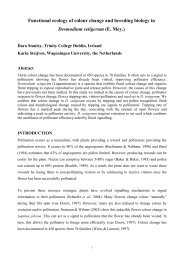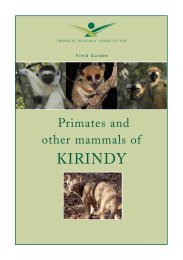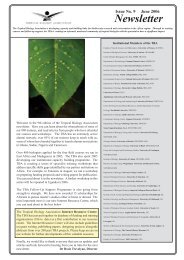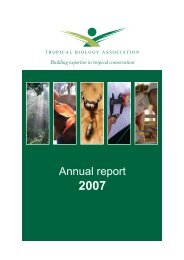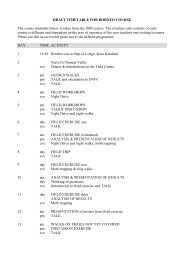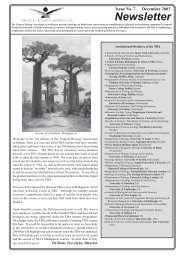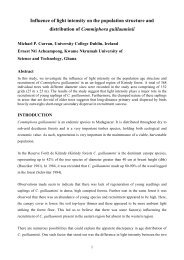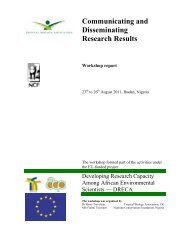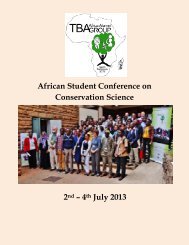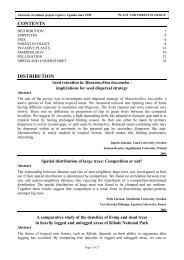Download TAAG Book of Abstracts - Tropical Biology Association
Download TAAG Book of Abstracts - Tropical Biology Association
Download TAAG Book of Abstracts - Tropical Biology Association
Create successful ePaper yourself
Turn your PDF publications into a flip-book with our unique Google optimized e-Paper software.
Rethinking Youth Capacity Development in Forest<br />
Governance: the Case <strong>of</strong> Wabane Subdivision in<br />
Cameroon<br />
* 1,2 Fomengia Dominic Nkenglefac, 3 Mbunya Francis<br />
Nkemnyi, and 4 Florence NgueiwohNyiawung<br />
1 Resource Centre for Environment and Sustainable<br />
Development (RCESD), Cameroon,<br />
2 University <strong>of</strong> Dschang, Cameroon<br />
3 Institute <strong>of</strong> Development Policy and Management<br />
(IOB), University <strong>of</strong> Antwerp, Belgium.<br />
4 Katholieke Universiteit Leuven, Belgium<br />
*E-mail for correspondence: dformengia@yahoo.com<br />
Abstract<br />
Building the capacity <strong>of</strong> and creating sustained<br />
partnerships with youths are crucial strategies to<br />
achieving sustainable forest governance (SFG).<br />
Unfortunately, this has not been given adequate<br />
attention in practice by the international and national<br />
development stakeholders. The Wabane Subdivision in<br />
the South West Region <strong>of</strong> Cameroon has an<br />
approximate population <strong>of</strong> 45,000 inhabitants with<br />
about 70% being youths. This study focused on how<br />
building youth capacity can contribute to SFG and on<br />
how different stakeholders have been involved in<br />
developing youth capacity that foster SFG. We also<br />
looked at the attitude and contributions <strong>of</strong> rural youths<br />
towards SFG and the challenges involved. We used mix<br />
survey methods including questionnaires, interviews,<br />
focus group discussions and field observations. The<br />
main findings showed that though youths are willing to<br />
contribute positively toward SFG, they are faced with<br />
many challenges including insufficient technical and<br />
financial capacity coupled with poor livelihood<br />
situations. We recorded that 57.7% <strong>of</strong> youths did not<br />
complete primary education due to poor financial<br />
situations, thus their engagements in forest-based<br />
activities (subsistence farming, hunting, etc) and early<br />
marriages. Pulling these arguments together, we<br />
recommend potential strategies that may improve<br />
youth capacity toward SFG.<br />
Keywords: Capacity building, sustainable forest<br />
governance, stakeholders and youth’s development.<br />
Preliminary Survey on the Distribution, Feeding Habit<br />
and Nesting <strong>of</strong> Yellow-Faced Parrot (Poicephalus<br />
flavifrons) in Tigray, Northern Ethiopia<br />
*Kiroswelegerima, Meheretu Yonas, Tsegazeabe<br />
Hadush, Solomon Kiros and Tadesse Dejenie<br />
Department <strong>of</strong> <strong>Biology</strong>, Mekelle University, P.O. Box<br />
3179, Mekelle, Ethiopia<br />
*Email for correspondence: lezelalem16@yahoo.com<br />
Abstract<br />
The yellow-faced parrot (Poicephalus flavifrons) is<br />
Ethiopian endemic species with poor recognition. In this<br />
study, we surveyed current distribution, ecology and<br />
major threats <strong>of</strong> the species in Tigray. The parrots were<br />
surveyed by direct observation and informal interviews<br />
with local residents to collect additional information in<br />
the surveyed area. The parrots were distributed in the<br />
south part <strong>of</strong> Tigray in a very fragmented area at the<br />
foot <strong>of</strong> Hugumburda and Grakahsu forest priority areas.<br />
Feeding sites were located in Waja, Arorsha, Tumuga,<br />
Adiborie, Alamata, Kukfto and Werabayo, mostly in<br />
residential backyards and agricultural fields including<br />
irrigated areas. The only overnight roosting site was<br />
located on the edge <strong>of</strong> Grakahsu forest. Daily activity <strong>of</strong><br />
the Yellow-faced parrot was peaked in the morning and<br />
again in the afternoon. Overall, 21 plant species were<br />
recorded as food <strong>of</strong> the yellow-faced parrot. The largest<br />
feeding flock (15 individuals) was recorded feeding on a<br />
single plant species <strong>of</strong> Acacia negrii at Werabayo. One<br />
active nest with juveniles and other ten nests which<br />
were in nest building stage were found at Adiborie and<br />
Alamata. The new records <strong>of</strong> the species extend the<br />
known range <strong>of</strong> the Yellow-faced parrot to northern<br />
Ethiopia. The most common threats recorded both in<br />
feeding and nesting site during the survey were habitat<br />
fragmentation, anthropogenic disturbance and erosion.<br />
This study provides baseline information and<br />
supplements the required information necessary for<br />
further detailed studies and conservation actions. The<br />
parrot is a potential key stone species for the<br />
conservation <strong>of</strong> Grakahsu and Hugumburda forests and<br />
adjacent habitats.<br />
Keywords:Anthropogenic disturbance, Conservation,<br />
Distribution, Yellow-faced Parrot




